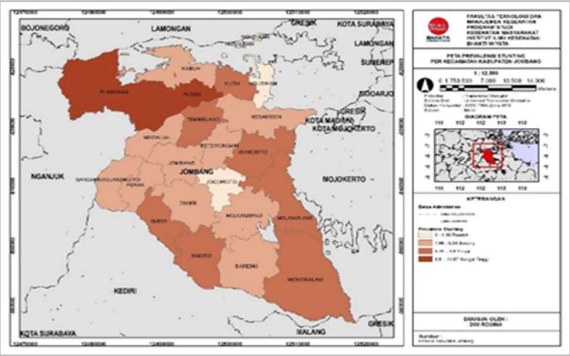Pola Sebaran Stunting di Kabupaten Jombang Tahun 2023 Menggunakan Analisis Geospasial
DOI:
https://doi.org/10.5281/zenodo.14560886Keywords:
Stunting, Geographic Information System, Spatial Autocorrelation , LISAAbstract
Background: Stunting is a type of growth failure caused by inadequate nutrition, which lasts from pregnancy up to 24 months. This research aims to map the distribution of stunting prevalence in young children using the Geographic Information System (GIS). Methods: This study uses a descriptive cross-sectional type by collecting secondary data on stunting cases in young children obtained from the Jombang District Health Office in 2023. Results: Research using Moran's test shows that based on the results of autocorrelation data does not show the existence of significant local spatial autocorrelation at the level of stunting prevalence in Jombang Regency in the absence of statistical significance in the results of the LISA test, while the results of the distribution pattern of the Lisa cluster test are not significant, there is no strong evidence of the group areas that are close to the same and low stunting conditions in Kabuh and Megaluh districts. Conclusions: The prevalence of stunting in Jombang Regency in 2023 does not show a significant pattern of spatial autocorrelation based on the results of the LISA test. Suggestions: By using GIS technology, we can map the stunting areas and identify the most vulnerable community groups. This information will be very useful in designing a properly targeted intervention programme and improving the quality of life of the community.
Downloads
References
Agustina, D. W. I. U. (2021). Analisis Faktor Resiko Kejadian Stunting pada Balita Literatur Review. Jurnal Kemenkes, 2(1), 180–187.
Aswi, A., Sukarna, S., & Nurhilaliyah, N. (2022). Pemetaan Risiko Relatif Kasus Stunting di Provinsi Sulawesi Selatan. Sainsmat : Jurnal Ilmiah Ilmu Pengetahuan Alam, 11(1), 11. https://doi.org/10.35580/sainsmat111325202022
Kamaruddin, M., Hasrawati, Usmia, S., Jusni, Misnawaty, & Handayani, I. (2019). Korelasi Antara Status Gizi Dan Kadar Hemoglobin Pada Kejadian Anemia Ibu Hamil Trimester Iii. Medika Alkhairaat : Jurnal Penelitian Kedokteran Dan Kesehatan, 1(3), 82–88. https://doi.org/10.31970/ma.v1i3.32
Kemenkes. (2023). Prevalensi stunting di indonesia turun ke 21,6% dari 24,4%. Kemenkes. https://www.kemkes.go.id/id/rilis-kesehatan/prevalensi-stunting-di-indonesia-turun-ke-216-dari-244
Kemenkes. (2022). Prevalensi Balita Stunting Provinsi Jawa Timur Menurut Kabupaten/Kota (2022). https://databoks.katadata.co.id/datapublish/2023/02/14/ini-rincian-angka-balita-stunting-di-wilayah-jawa-timur-pada-2022-kabupaten-jember-terbesar
Kementerian Sekretariat RI. (2022). No Title. Kementerian Sekretariat RI. https://stunting.go.id/
Lestari et. (2022). Penerapan Model Spasial Durbin Dengan Uji Lanjutan Local Indicator of Spatial Autocorrelation Untuk Melihat Penyebaran Stunting Di Kabupaten Bone Bolango. Jambura Journal of Probability and Statistics, 3(1), 19–28. https://doi.org/10.34312/jjps.v3i1.13083
Mar’atik, K., & Muniroh, L. (2023). Hubungan Praktik Pemberian Makan dengan Kejadian Stunting pada Balita di Wilayah Kerja Puskesmas Plosoklaten Kabupaten Kediri. Media Gizi Kesmas, 12(2), 738–742. https://doi.org/10.20473/mgk.v12i2.2023.738-742
Mirza, M. M., Sunarti, S., & Handayani, L. (2023). Pengaruh Status Gizi Ibu Hamil terhadap Kejadian Stunting: Studi Literatur. Jurnal Kesehatan Masyarakat Indonesia, 18(2), 22. https://doi.org/10.26714/jkmi.18.2.2023.22-27
Olo, A., Mediani, H., & Rakhmawati, W. (2020). Hubungan Faktor Air dan Sanitasi dengan Kejadian Stunting pada Balita di Indonesia. Jurnal Obsesi : Jurnal Pendidikan Anak Usia Dini, 5, 1113–1126. https://doi.org/10.31004/obsesi.v5i2.788
Pebrianty, (2023). Autokorelasi Spasial Prevalensi Stunting di Jawa Barat Tahun 2021. Jurnal Biostatistik, Kependudukan, Dan Informatika Kesehatan, 3(1), 14. https://doi.org/10.51181/bikfokes.v3i1.6386
Wardana, (2023). Analisis Spasial Keluarga Berisiko Stunting dengan Kejadian Stunting di Provinsi Jawa Barat Tahun 2022. Sistem Informasi Akademik Sekolah Tinggi Ilmu Kesehatan Dharma Husada Bandung, 2022, 1–9.
Yustanti, D. A. (2024). Relationship Between Fast Food Eating Behaviour and Prevalence of Obesity in Children Aged 7-12 Years in Nganjuk, Indonesia. Ficco Public Health Journal, 1(01), 1-6.
More
Downloads
Published
Issue
Section
License
Copyright (c) 2024 Dwi Regina Istiqlala, Mohamad Anis Fahmi (Author)

This work is licensed under a Creative Commons Attribution 4.0 International License.

